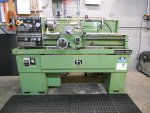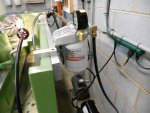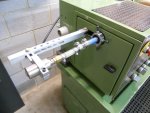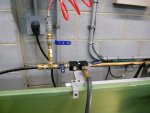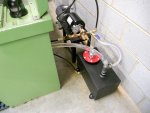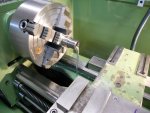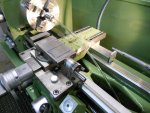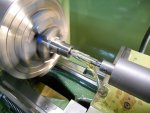Donald: I used a standard ball valve for the pump/tank return bypass and the other "valving" on my system and they work great.
Some of you may remember the pics I posted of my flush system from few years ago. I have recently (2014) made a few changes/improvements to the system, specifically I went with a larger pump, external tank, new filter system, an "air injection" line purge, and larger ID tubing. It works fantastic. ....And for the record, I tried many different lubricants, coolants, and fluids but found none to work better that Re-li-on. I'll add a little detail to hopefully help save others a little time and a few bucks as I have arrived at my current configuration by trial and elimination.
Following a drop of Re-li-on through the system: Beginning in the 4 gallon tank it flows through an in line screen filter, a vacuum gauge, and into the Shurflo GCBN33Y carbonator pump. From there I can direct/control the flow either to the flush system or back into the tank via a bypass valve. This adds greatly in the volume control and adjustability. It then goes up to a Baldwin filter base that I modified to accept Ford type FL1A filters. I drive a F150 (official vehicle of the conservative white male) and the filters are inexpensive and available everywhere. From there to a 4 port manifold block with a port tapped for a coolant line when threading etc. A set of ball valves controls flow to the bleed off line or continuing flow to the rotary union. I stole an idea from D. Tooley and added a purge line which incorporates an automotive fuel system check valve to prevent oil flow back up into the line. The air purge works great when checking progress on a chamber by pushing out all the fluid quickly and easily. We then travel through the Duff Norton stainless rotary union and into the barrel. No special taps or spring loaded gizmos are needed - just a simple nipple adapter that took 10 min to make and I can clamp onto most any barrel with simple hose clamps. No, it does not leak and does not come off under pressure. Through the barrel, into the lathe's chip pan we travel, past a few magnets and screens, and then gravity drain back into the external tank via a couple of fittings and clear 1.50" hose completes the journey. Everything was approx. $1000 and worth every penny. If I had to go back to the old way of dip-ream-clean-repeat ad nauseam I would take up golf.
I indicate, predrill, pre-bore to within .030" or so of shoulder dia, then taper bore, then ream with a JGS holder. Cuts like butta. Flip the pump switch, adjust the flow, and cut a great chamber in a fraction of the time.
I'll try and add a few pics for clarity.
Opinions by,
SR


